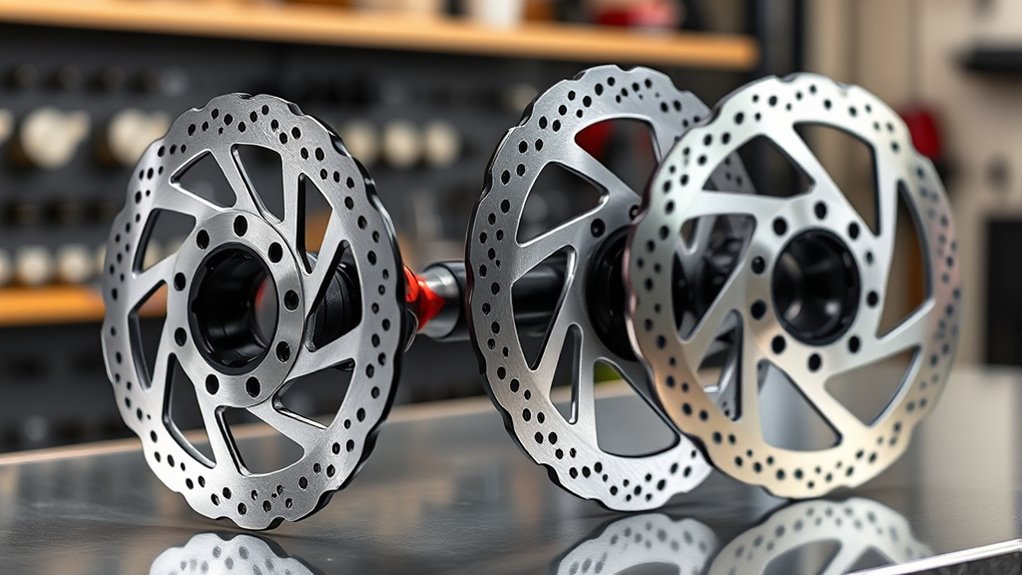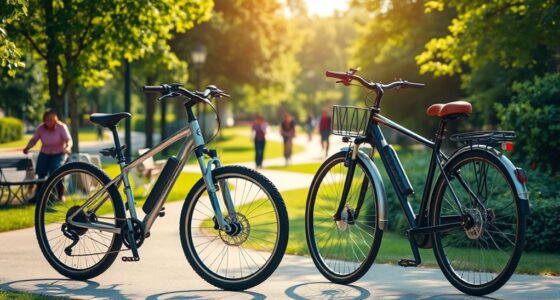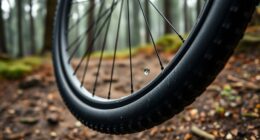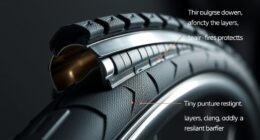Choosing between 140mm, 160mm, and 180mm disc rotors depends on your riding style and terrain. Smaller rotors like 140mm are lightweight and responsive, ideal for cross-country or casual riding. 160mm offers a good balance for everyday use, while 180mm provides maximum stopping power for downhill or aggressive riding. More details on how each size affects your bike’s performance and maintenance will help you make the best choice.
Key Takeaways
- 140mm rotors are lighter and ideal for cross-country or casual riding, offering quick responsiveness.
- 160mm rotors provide a balanced option suitable for general riding and moderate terrains.
- 180mm rotors deliver increased stopping power and heat dissipation for downhill or heavy load riding.
- Larger rotors (180mm) may require more maintenance due to higher heat and wear; smaller rotors (140mm) are easier to maintain.
- Choose rotor size based on riding style and terrain: smaller for agility, larger for heavy-duty braking needs.

When choosing disc rotors for your bike, understanding the differences between 140mm, 160mm, and 180mm sizes is essential. The rotor size directly impacts your braking performance, as larger rotors generally provide more stopping power and better heat dissipation. Smaller sizes, like 140mm, are typically suited for lightweight bikes or riders prioritizing nimbleness, while larger sizes, like 180mm, are better for downhill riding or heavy loads where strong, consistent braking is crucial. Knowing how each size influences braking performance helps you select the right rotor for your riding style and terrain.
In terms of braking performance, larger rotors tend to offer increased leverage, resulting in more powerful braking, especially under prolonged or heavy use. They help prevent brake fade by dispersing heat more efficiently, which is vital during steep descents or extended rides. Conversely, smaller rotors like 140mm may feel less aggressive but are lighter and more responsive for casual or cross-country riding. They also reduce weight, which can enhance overall bike handling. Your choice should reflect your typical riding conditions—if you often tackle challenging descents, a larger rotor will give you more control, whereas for lighter day-to-day rides, a smaller size might suffice.
Maintenance requirements also vary with rotor size. Larger rotors, while offering improved braking, tend to generate more heat and can experience more wear over time, which means you’ll need to check for warping or warping-related issues more frequently. They may also require more meticulous cleaning to prevent debris buildup that affects braking performance. Smaller rotors are generally easier to maintain because they generate less heat and tend to stay cooler, reducing the risk of warping. However, because they provide less braking power, you might find yourself applying more force, which can lead to quicker pad wear if not managed properly. Additionally, selecting the appropriate braking system can influence overall performance and maintenance needs. Regardless of size, regular inspection and cleaning are necessary to keep your braking system functioning optimally.
Ultimately, your choice hinges on your riding style, terrain, and preferences. Larger rotors like 180mm excel in demanding conditions but come with increased maintenance considerations. Smaller rotors like 140mm are lighter and easier to care for but may not deliver enough stopping power for aggressive riding. Understanding how each size affects braking performance and maintenance helps you make an informed decision, ensuring your bike’s braking system matches your needs and keeps you safe on every ride.
Frequently Asked Questions
How Do Disc Rotors Impact Overall Braking System Lifespan?
Choosing the right disc rotor size influences your braking system’s lifespan by affecting brake pad compatibility and rotor wear patterns. Larger rotors, like 180mm, typically last longer because they distribute heat better and reduce wear. Smaller rotors may wear faster, requiring more frequent replacements. Proper sizing ensures even pad wear and maximum heat dissipation, ultimately extending the overall lifespan of your braking components.
Can Rotor Size Affect Bike Handling During Emergencies?
Yes, rotor size can affect your bike handling during emergencies. Larger rotors, like 180mm, offer better brake modulation and increased stopping power, which helps you control sudden stops more smoothly. However, they also add weight, making your bike feel less agile. Smaller rotors, like 140mm, are lighter and easier to manage, but might lack the same stopping strength in critical moments. Choose based on your riding style and safety needs.
Are Larger Rotors Suitable for All Types of Mountain Biking?
Larger rotors might seem like the ultimate upgrade, but they aren’t perfect for every mountain biking adventure. You need to evaluate brake pad selection and rotor compatibility to avoid a disaster. While 180mm rotors excel on steep, technical descents, they can be overkill for cross-country rides. For versatile performance, match rotor size to your bike’s design and riding style, ensuring smooth stops without sacrificing handling.
What Maintenance Differences Exist Between 140MM and 180MM Rotors?
With 140mm rotors, maintenance is simpler; you’ll find brake pad replacement and rotor cleaning easier and quicker. For 180mm rotors, expect more effort during pad changes and cleaning due to their larger size. The increased surface area may require more frequent cleaning to prevent debris buildup. Overall, larger rotors demand a bit more maintenance, but they also provide better heat dissipation and braking power.
Do Larger Rotors Increase the Risk of Wheel Damage?
Larger rotors can increase the risk of wheel damage because they generate more brake heat and may cause rotor flex, especially if your wheel isn’t designed for the bigger size. The increased heat can weaken components over time, and rotor flex might lead to uneven braking. Make certain your wheel and bike frame are compatible with bigger rotors to prevent damage and maintain safe, effective braking performance.
Conclusion
Choosing the right disc rotor size depends on your riding style and terrain. For city commuting, a 140mm rotor keeps things lightweight and nimble. If you’re tackling hilly trails, a 180mm rotor offers better stopping power. Imagine a rider descending a steep mountain trail—switching from 160mm to 180mm rotor made all the difference in control and safety. Pick the size that matches your ride, and you’ll enjoy smoother, more confident braking every time.








